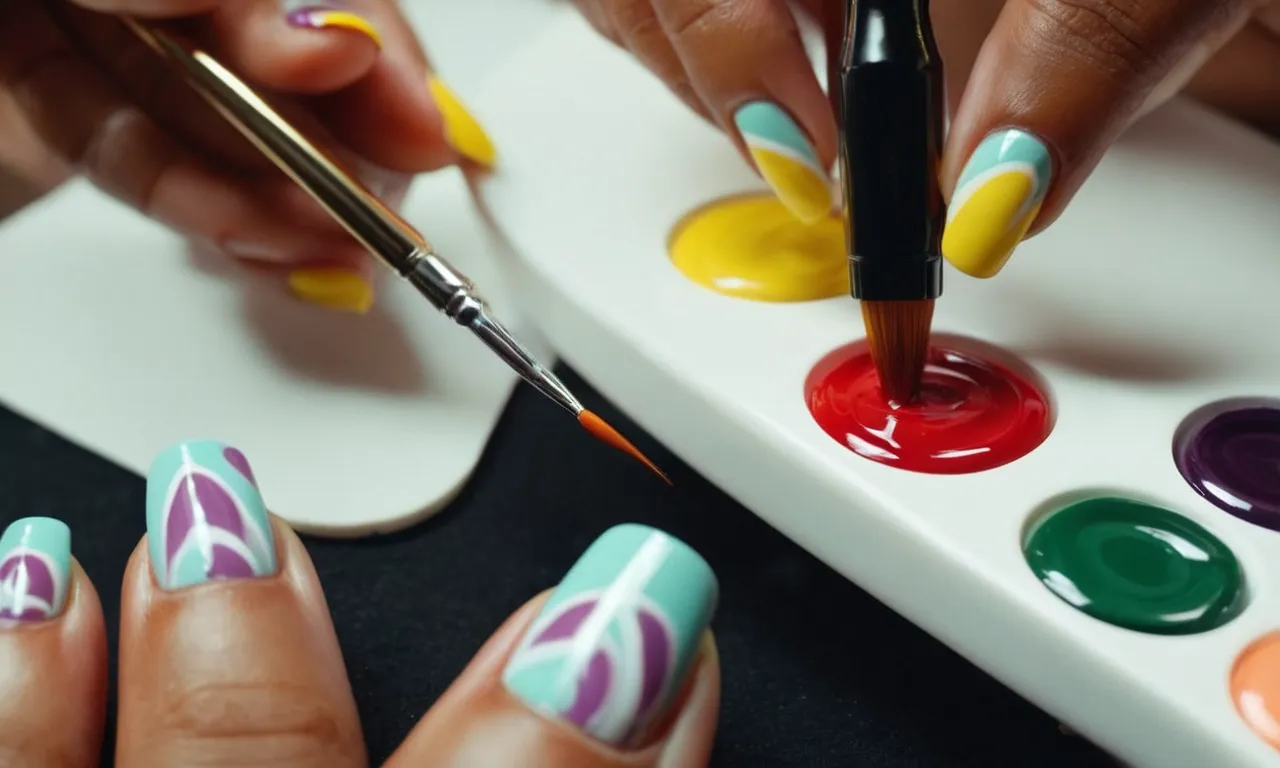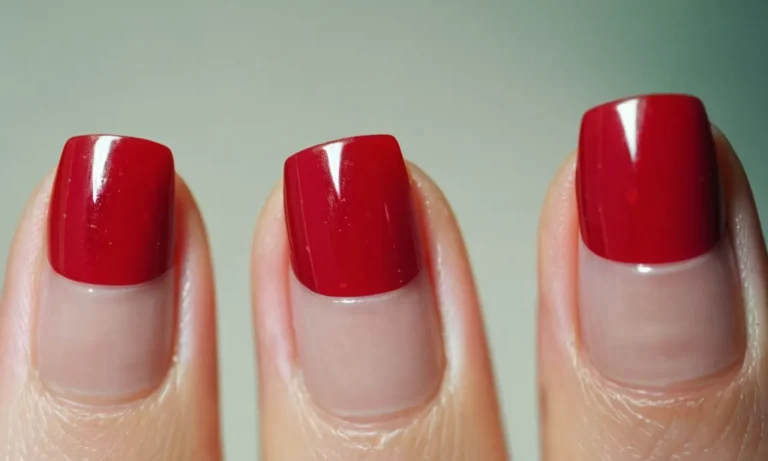Can I Use A Paint Brush For Acrylic Nails?
Having beautiful nails has become a trend nowadays with the popularity of nail art. Many women are starting to do their own acrylic or gel nails at home to save money on frequent salon visits. A common question asked is if regular paint brushes can be used to apply acrylic nail products instead of the special nail brushes.
The quick answer is: Yes, you can use a regular paint brush for acrylic nails if you don’t have a nail brush, but it won’t work as well as a proper acrylic nail brush that is designed specifically for applying acrylic products to the nails.
Nail brushes have finer tips and are more rigid to allow for precision application.
Challenges of Using a Paint Brush for Acrylic Nails
Lack of Fine Pointed Tip
Unlike professional acrylic brushes that have a fine pointed tip, the tips of paint brushes are much thicker and blunter (1). This makes it incredibly difficult to paint precise, intricate nail art designs. The bristles are simply too thick to create fine lines or details.
Bristles Bend Easily
Paint brush bristles are typically made of softer, more flexible materials like nylon or synthetic hairs (2). While this is good for smoothing paint onto canvas or walls, it causes problems when trying to sculpt acrylic powder.
The bristles tend to bend when applying any pressure, making it hard to properly shape the enhancement around the natural nail.
Difficulty Getting Close to Cuticles
The thickness of paint brush bristles also prevents getting product close to the cuticle area. But keeping product off the skin is crucial to prevent lifting and infections down the road (3). Professional acrylic brushes have a much thinner profile to promote precise application.
Doesn’t Hold Enough Product
An acrylic brush is designed to hold the perfect amount of liquid monomer or acrylic power as you work. But standard paint brushes simply cannot carry enough product to efficiently apply extensions. This slows down the entire application process as you frequently have to stop and reload the brush (4).
While it may seem convenient to use a paint brush you already own, attempting acrylic nails with the wrong tools leads to messy, imperfect results. Investing in quality professional brushes designed specifically for nail enhancement application saves time and frustration.
Types of Acrylic Nail Brushes
Kolinsky Sable Hair Brushes
Kolinsky sable hair brushes are considered the gold standard for acrylic application. The natural sable hairs have a fine pointed tip that holds acrylic perfectly. This allows you to create beautiful, crisp acrylic nail extensions with flawless cuticle work.
While natural hair brushes are more expensive, their quality is unmatched. Investing in a high-end Kolinsky brush will give you amazing control and last for years with proper care. Just be sure to clean it well between uses to maintain the delicate tips.
Synthetic Nylon Brushes
Synthetic nylon brushes are a great affordable option for beginners. The nylon bristles can mimic the fineness of natural sable hair while being easier to clean. While the quality won’t be as exceptional as Kolinsky brushes, you can still achieve lovely acrylic applications.
Look for nylon brushes with a fine point and tightly packed bristles. Avoid brushes that feel too soft or flexible. Stiff, dense bristles will hold acrylic better. With practice, synthetic brushes can allow you to do all basic acrylic nail services.
Many top brands like Young Nails offer synthetic lines that offer salon-quality performance without the big price tag.
Disposable Brushes
Disposable applicator brushes provide a hygienic, cost-effective option for acrylics. They have synthetic bristles shaped like traditional nail brushes. While the quality is not outstanding, they get the job done for occasional use. Many nail techs keep them on hand for quick repairs or fill-ins.
They help prevent cross-contamination since you simply toss them after each use. They are also great for practice. Nail school students often learn with disposables before investing in better brushes. Some drawbacks are that disposables don’t hold as much product.
They may require more frequent dipping during application. Overall, disposables work in a pinch but frequent acrylic users will want a more durable brush.
Tips for Using a Paint Brush for Acrylics
Choose a Small, Fine-Pointed Brush
When using a paint brush for acrylic nails, it’s important to choose a brush with a very fine point. Look for a brush with tightly packed bristles and a tip that comes to a nice, thin point. This allows you to paint on acrylics smoothly and precisely.
Avoid brushes that are too thick or have a blunt cut to the bristles. Thick brushes don’t give you enough control and make it hard to do detail work like creating a french tip or painting nail art designs.
Look for a brush in a size #3/0 or #5/0. The lower the number, the finer and smaller the brush. This gives you the control you need.
Look for Stiff Bristles
Acrylic nail products are thick, so you need a brush with bristles that are stiff enough to move the product around easily. Nylon or synthetic bristles tend to be stiffer than natural hair.
Make sure the bristles aren’t too soft or flexible or the acrylic will bend them out of shape. You want the bristles to hold their shape as you work.
You can find acrylic nail brushes made specifically for this purpose. Or look for stiff, synthetic watercolor paintbrushes.
Frequently Dip Into Monomer and Wipe Off
No matter what type of brush you use for acrylic nails, you’ll need to dip it into monomer liquid frequently as you work. This keeps the bristles from getting clogged with dried acrylic.
However, you don’t want the brush to be dripping with liquid. Wipe it along the edge of the monomer jar after dipping to remove excess. Too much liquid will flood the nails and cause the acrylic to run.
Get into a rhythm of dipping the brush into the monomer, wiping off excess, then into the acrylic powder, applying, and repeating. This keeps the bristles supple and the acrylic flowing smoothly.
Work Slowly and Carefully
It takes practice to get the hang of using a brush to apply acrylic powder. Don’t rush or try to apply too much at once. Work slowly and carefully as you get used to handling the brush.
Pay attention to how the bristles move the product. Use a very light touch and even strokes. Let the tool do the work rather than pushing down too hard.
If you go slowly and focus on control, you’ll be able to create an even, flawless acrylic nail surface. It just takes time and patience as you practice this new technique!
The Risk of Lifting or Damage
Using a paint brush to apply acrylic nails certainly seems convenient, but there are some risks to consider. Here are some of the main concerns when using a paint brush instead of professional nail tools:
Lifting
Acrylic nails applied with a brush may not adhere as strongly to the natural nail. Without the proper prep work and application methods, there is an increased risk of the acrylic lifting or popping off prematurely.
This can lead to an unprofessional look and damage to the natural nail underneath if it is not removed properly.
Inconsistent Application
It is difficult to get an even, smooth application using just a paint brush. The acrylic may end up bumpy or thick and thin in different areas. Proper shaping and filing requires specific professional tools to get a nice uniform look.
Overexposure to Chemicals
Acrylic nail products contain chemicals like methyl methacrylate that can be harmful with overexposure. Using a simple paint brush means you are closer to the chemicals and acrylic liquid for a longer period of time compared to professional application.
Make sure to work in a well-ventilated area and use gloves to minimize exposure.
Cuticle Damage
Pushing back and cleaning up the cuticles is an important step before acrylic application to avoid lifting. It is difficult to properly manage the cuticles using just a brush. You may end up with adhesive on the skin or damage the cuticles by trying to scrape them back.
Filing Issues
Acrylic nails should be filed and shaped by an expert using specialty files and tools. Attempting to file bumps or shape the nails with a simple nail file can lead to weakness, cracking, and lifting of the acrylics from too much stress on the product.
While using a paint brush to apply acrylics may save money and seem easy, the results are rarely as durable and attractive as going to a professional. Leaving application to the experts helps avoid damage or exposure to chemicals. Go to a trusted nail salon if you want acrylics that will last!
Conclusion
While it’s possible to use a paint brush in a pinch, investing in quality nail brushes designed for acrylic application will provide the best control and keep your at-home manicures looking polished. Take care when applying product, work slowly, and don’t overload the bristles to minimize mistakes.
With practice, you’ll be doing salon-worthy nails from the comfort of your own home.







